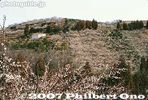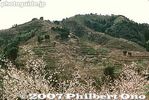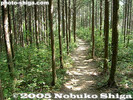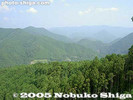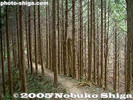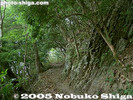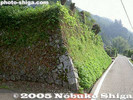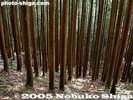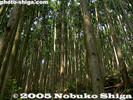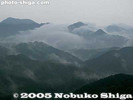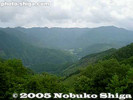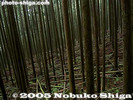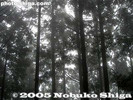 Image search results - "wakayama" Image search results - "wakayama" |

Minabe boasts Japan's largest plum tree groves. The trees cover the mountain slopes and a sweet aroma prevails. JR Minabe Station
|
|
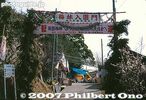
Entrance to Minabe Plum Grove. The best time is around mid-Feb. 南部梅林
|
|
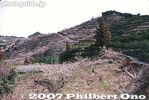
Slopes covered with plum trees.
|
|
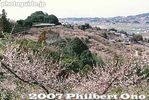
Plum blossoms
|
|
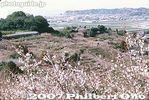
An awesome sight in Minabe, Wakayama.
|
|
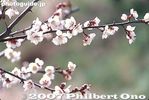
Plum blossoms
|
|
|
|
|
|
|

Near Tanabe
|
|
|
|
|
|
|
|
|
|
|
|
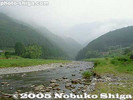
Chikatsuyu
|
|
|
|
|
|
|
|
|
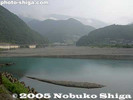
Hagi
|
|
|
|
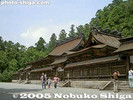
Kumano Hongu Shrine
|
|
|
|
|
|
|
|
|
|

小雲取越小雲取越
|
|
|
|
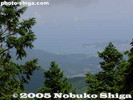
舟見峠
|
|

Nachi Falls 那智大滝
|
|

Katsuura 勝浦
|
|
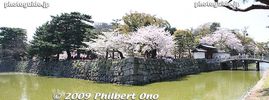
Wakayama Castle is a short bus ride from JR Wakayama Station. The East Moat (東堀) is what you see when you get off at the Koen-mae bus stop. The Ichinohashi Bridge at Otemon Gate is on the right.
|
|

Ichinohashi Bridge (一の橋) leading to Otemon Gate (大手門) is the main entrance to the Wakayama Castle, open 9 am - 5:30 pm. Closed Dec. 29-31. Both the bridge and gate were reconstructed in 1983.
|
|

Wakayama Castle is famous for cherry blossoms in early April. I visited when it was in full bloom.
|
|

A partial maze to make it harder for any attackers to enter the castle. 一中門跡
|
|

Path to Omotezaka entrance.
|
|

Castle foundation wall
|
|

Ninomaru Garden is full of cherries. The Ninomaru was the site of the castle palace where the lord and his ladies resided. 二の丸庭園
|
|

Entrance to Ura-zaka Nobori-guchi sloping path to the tenshukaku castle tower (donjon). 裏坂登り口
|
|

Castle tower overlooks Ninomaru.
|
|

The Ura-zaka sloping path to the castle tower is a mild climb up.
|
|

Tree growing on castle wall.
|
|

Wakayama Castle is noted for various styles of castle wall. 野面積み
|
|

Steps up to the castle tower.
|
|

Wakayama Castle was originally built in 1585 by Toyotomi Hidenaga upon the order of elder brother Hideyoshi. The construction was directed by renown castle architect Lord Todo Takatora, native of Omi (Shiga Prefecture).
|
|

In 1619, Tokugawa Yorinobu, Ieyasu's 10th son, became the castle lord establishing the Kii clan, one of three key Tokugawa Gosanke clans (along with Owari and Mito).
|
|

Almost to the castle tower.
|
|

Wakayama Castle tower was struck by lightning in 1846 and destroyed by fire. It was rebuilt in 1850 by special permission from the shogunate which normally did not allow castles to be rebuilt.
|
|

Wakayama Castle tower was destroyed again by World War II bombing on July 9, 1945. It was reconstructed in ferro-concrete in Oct. 1958.
|
|

Wakayama Castle tower is now a modern museum with three stories.
|
|

Cherry blossoms on the way to the castle tower.
|
|

Site of Ichinomon Gate. 一の門跡
|
|

Cherries droop over a castle wall.
|
|

Stone foundation wall of the castle tower.
|
|

Finally we see the main castle tower amid cherry blossoms.
|
|

Wakayama Castle tower (donjon).
|
|

Wakayama Castle tower (donjon) and cherry blossoms.
|
|

The 50-year-old castle tower is in need of a paint job.
|
|

The castle tower is in need of a paint job.
|
|

Wakayama Castle
|
|

Wakayama Castle in April.
|
|

Wakayama Castle's main castle tower is connected to a corridor leading to two other turrets. On the left is the entrance to this castle tower complex (tenshu-kuruwa 天守郭).
|
|

Entrance to the castle tower complex is via this gate called Kusunoki-mon. 楠門
|
|

Kusunoki-mon 楠門
|
|
|

Steps tp Kusunoki-mon Gate.
|
|

Kusunoki-mon Gate (front side), reconstructed in 1950. This gate was lost along with the castle tower in July 1945. 楠門
|
|

Kusunoki-mon (back side) 楠門
|
|

Wakayama Castle tower and Kusunoki-mon Gate.
|
|
|
|

Cherry blossoms and Wakayama Castle tower.
|
|

Inui Turret 乾櫓
|
|

Castle tower exit
|
|

Castle tower entrance roof has a Chinese cusped gable (karahafu). 唐破風
|
|

Wakayama Castle as seen from inside the tower complex.
|
|

Castle tower stone foundation wall.
|
|

Inside Wakayama Castle tower, a museum.
|
|

Samurai armor, etc., are displayed.
|
|

Top floor of Wakayama Castle tower with a nice balcony for fine views of Wakayama.
|
|

Model of Wakayama Castle
|
|

Portrait of Tokugawa Yorinobu. His descendants went on to produce six Tokugawa shoguns: Yoshimune, Ieshige, Ieharu, Ienari, Ieyoshi, and Iemochi (Yoshitomi).
|
|

Portrait of Shogun Tokugawa Yoshimune who was from Wakayama.
|
|

Pistol
|
|

On the lookout deck of Wakayama Castle, looking toward Kusunoki Gate and Ninomon Turret.
|
|

From the lookout deck of Wakayama Castle, you can see the connected corridors leading to the two turrets.
|
|

Looking toward Inui Turret
|
|

Looking toward Inui Turret
|
|

Inui Turret and cherry blossoms. 乾櫓
|
|

Wakayama's industrial complex in the distance.
|
|
|
|

Lookimg toward Omotemon Gate.
|
|

Corridor to Ninomon Turret. The corridor is connected to the main castle tower (donjon).
|
|

Stairs to Ninomon Turret.
|
|

Inside Ninomon Turret, totally modern with hardly any views. Caged windows do not help at all. 二の門櫓
|
|

Corridor leading to Inui Turret.
|
|

Stairs to Inui Turret.
|
|

Inside Inui Turret 乾櫓
|
|

View of Wakayama castle tower from Inui Turret.
|
|

Wakayama Castle as seen from Inui Turret.
|
|

Wakayama Castle
|
|

The final corridor leads to the exit.
|
|

Basement steps
|
|

Inui Turret
|
|

Markings can be found on the stones.
|
|
|

Oimawashimon Gate. Renovated in 1985. 追廻門
|
|

Tree growing on castle stone foundation.
|
|
|

North Moat 北堀
|
|

From the North Moat, we see the Ohashiroka Bridge which was completed in April 2006.
|
|

Wakayama Castle's Ohashiroka Bridge and the castle tower. The bridge is a corridor connecting Ninomaru and Nishinomaru. 御橋廊下
|
|
|

Wakayama Castle's Ohashiroka Bridge is a covered corridor connecting Ninomaru and Nishinomaru. Only the castle lord's immediate attendants could cross the bridge, and so it was completely covered. 御橋廊下
|
|

Entrance to Ohashiroka Bridge which was completed in April 2006. Free admission.
|
|

The Ohashiroka Bridge is made of wood with a slight slope. It is a rare castle structure. 御橋廊下
|
|

Inside Ohashiroka Bridge. The floor has planks of wood whose edges are kind of painful for bare feet. (You have to take off your shoes to enter.)
|
|

View from inside Ohashiroka Bridge, looking toward the North Moat.
|
|

View from inside Ohashiroka Bridge, looking toward the castle tower.
|
|

Ohashiroka Bridge entrance on the other end.
|
|

Ninomaru
|
|

Entrance to Nishinomaru Teien Garden. Also called Momijidani Teien Garden.
|
|

Nishinomaru Teien Garden was originally built by Tokugawa Yorinobu. Renovated in 1973. Noted for maple leaves in fall, a pond, and a floating pavilion called the Engyokaku (鳶魚閣) (left).
|
|

Inside the Engyokaku pavilion (no entry).
|
|

Nishinomaru Teien Garden
|
|

Nishinomaru Teien Garden pond. The garden is a National Scenic Place.
|
|
|
|
|
|

Wakayama Castle is on 48.9-meter-high Mt. Torafusu (虎伏) which resembles a tiger lying on its side when seen from the ocean. The castle is also called Torafusu-jo (lying tiger castle). This tiger statue was created in 1959.
|
|

Omote-zaka steps to the castle tower.
|
|
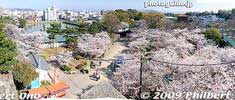
Panoramic view of cherry blossoms and Okaguchi-mon Gate.
|
|

Okaguchi-mon Gate and cherry blossoms. This part of the castle has the heaviest concentration of sakura.
|
|

Path to Okaguchi-mon Gate, the castle's back entrance built by Tokugawa Yorinobu.
|
|

Okaguchi-mon Gate, an Important Cultural Property. One of the few structures still remaining from the Edo Period. 岡口門
|
|

Okaguchi-mon Gate, seen from the outside. In 1960, it was disassembled and repaired.
|
|

Cherry blossoms as seen from Okaguchi-mon Gate.
|
|

Sakura near Okaguchi-mon Gate.
|
|
|
|
|
|

Sakura along the east moat.
|
|
|
|

Map of Wakayama Castle.
|
|
|
|
|
|






